New aquisition with memories: a surprise workstation and some 8-bit stuff, too
I've been asking my friend Peter for certain pieces of old hardware for quite some time. I wanted a Sun workstation and some 8-bit Z80-based micro in particular. He has a huge and really impressive collection of old hardware, and he said he can lend me some of these, and it is likely that he will not need them. This week finally I got into the warehouse he is renting. While the surroundings are nice in my view (and old factory area, industrial buildings, tubes, and abandoned industrial tracks everywhere… I grew up in an industrial area, so I felt comfy), the warehouse itself is dark and stuffy, no electricity there - not the ideal place. I hope he will find a better place for his treasury at some point. But the hospitality of him and his friend Sandor, and the collection itself compensated for the circumstances. After an hour of rejoicing around the collection, I left with a nice catch. Let's see what I've got.
First of all, this one. A Sun SparcStation LX:
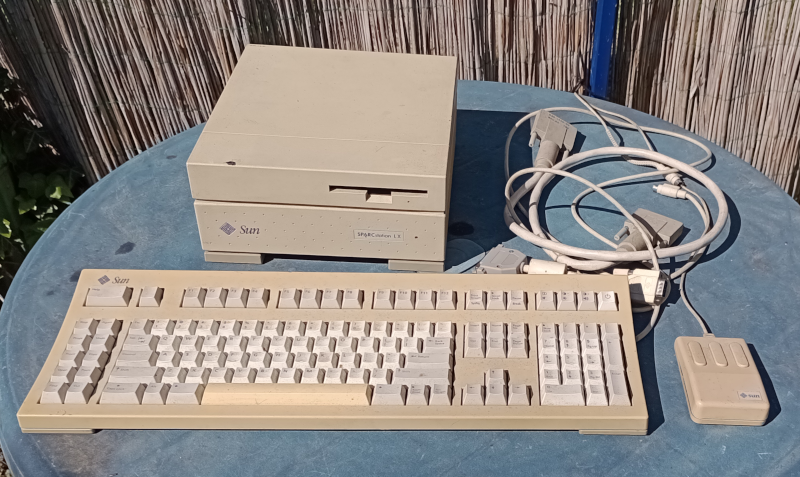
Unlike old PC-s, these bring back a lot of memories to me. When I started my work at the the Institute around 1998 as a graduate student in Physics preparing my diploma work, my supervisor, Prof. Janszky assigned an office to me. He always knew how to make youngsters enthusiastic: I had an office with an internal phone at the Institute, as a graduate student Of course I wanted to show I deserve it! And, what's more, it had a SparcStation Classic in it, almost the same machine as the one in the picture. It was not a new machine but a very good one. It had an outdated Solaris on it, and I had no installation material for it, so I installed RedHat 4.0 which was available for Sparc platforms. And I worked a lot with that: my first papers, my diploma work, and all these were calculated and typeset on that machine.
Then, while working also at the Institute, I became a PhD Student at University of Pécs, in 1999. The Faculty of Science was lacking the UNIX culture I was used to, this place had no tradition in computer science. People were using PCs with Windows on it, it wasn't like a place where serious people like mathematicians, computer scientists, or theoretical physicists work. And one day the leader of one of the computer science departments returned from Paderborn with a van full of Sun SparcStations. This changed the game. Initially the machines ran Solaris, and I started to teach students to work with the shell and write C programs. Then me and my friends, László Pere, the author of the best books about Linux in Hungarian, and Bogdan Zaválnij, we have put together the first Linux-based labs, using the SparcStations as thin clients as they started to get outdated. This became the basis of the future IT infrastructure of the faculty. At a point I asked for one of the workstations to have it in my office on my desk. It was an LX. I was using it as my daily driver with its genuine Solaris for some years and I loved it. And albeit it was already more than 10 years old, it was still competitive with that day's PCs.
Indeed, at the beginning of the 1990-s, when these machines were new, they were absolutely superior to PCs. They were not home computers, they were designed for professionals to do data processing, programming, science, etc. So they are not attractive for gamers as they weren't intended to that market. For me, however, they were the dream computers: I wanted to be an academic who is doing serious work with one of these.
The Sparc CPUs in them had roughly the performance of a Pentium II. They shipped typically with 32M of RAM and some 600 megs of SCSI HDDs, excellent keyboards, and optical mice. PCs had 386-s or 486-s that time. Alright, the displays were not the strength of Sun workstations in particular, they were big and high resolution, but low color depth. The very graphical workstations were called Indigo that time… Nonetheless, I have a SparcStation here again.
I gave it a good clean, and took a closer look on what I have:
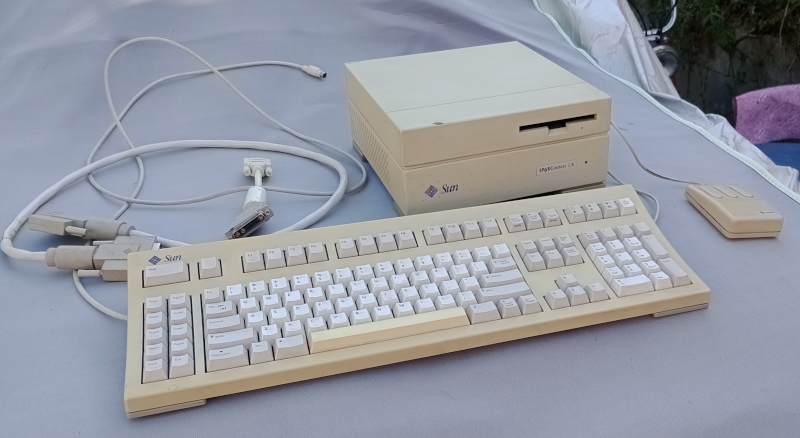
So this is a SparcStation LX, just like the one I had. It has the keyboard and the mouse, which is nice because it is not compatible with any PC or other hardware. It does have the monitor cable but not the monitor. These Sun machines had their special RGB monitors and weren't compatible with anything else, so this may look frightening. But I don't mind - I have no room for a CRT, and they are hard to maintain nowadays anyway. There are converters available for these to run with current monitors, and I do seem to have one, it has a VGA plug on the other side. However, I'm not sure if it will work or if someone just tried to experiment with it. We shall see. What is also missing is the mouse pad - it is an old-school optical mouse and it will not work without its own pad.
But there are many more questions. Will it work? Are the caps OK inside after so many years. Will the floppy drive work? Is there a HDD inside? In fact, Peter told that he was given these workstations from a chap who saved them from being sent to the landfill at some University, maybe it was the one I worked at. He said there were LXes used as thin clients there, so there may not be a HDD inside. Here I started to wonder… is it possible that this very workstation was from the lot we received from Paderborn that time? And the big surprise came here: I found my own ex-desktop's hostname handwritten on it. Good lord, this is maybe my old machine? I'm really excited. I'll let you know if I find out.
The story starts to get lengthy, so finally let's take a look of what else I've got. As of the Z80 micro, a Videoton TV Computer has dropped in:
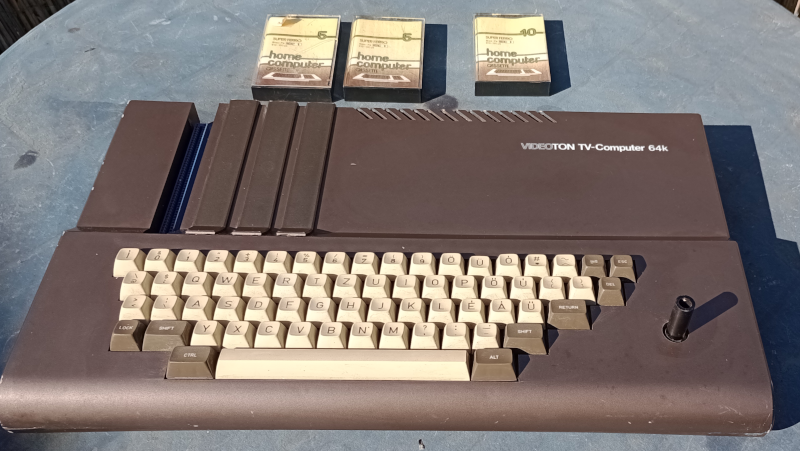
This is a Hungarian Z80-based micro intended for the home computer market in the 1980-s. Videoton was manufacturing more serious machines, even Unix workstations, too. And this one, while declared to be a home machine, had versatile extension ports and could be adopted to serious applications, too. A friend of mine, Zoltán Kurucz, who passed away a few years ago, used to be a member of its development team, he said they even adopted operating systems for business use on it. The reason for me to get in hold of one of these is that I've found a good book on Z80 assembly, but this is another story. In the background you can see a 10-minute and two 5-minute compact cassettes intended for home computer use in the 1980-s:
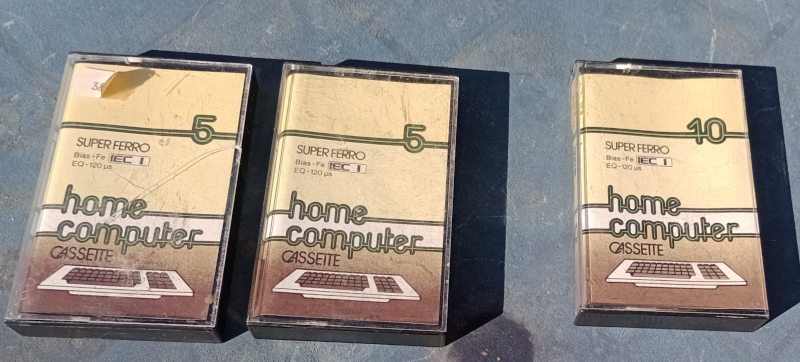
While I will use these with my Plus/4, they bring back a lot of childhood memories…
Finally, let me show the heaviest item of all:
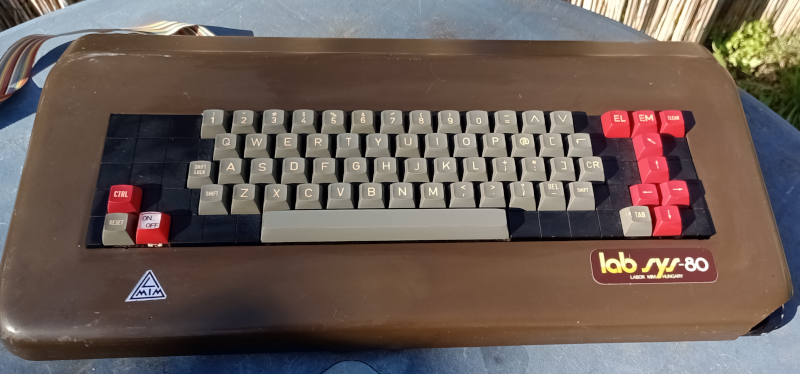
It is a shame but I did not yet check what the heck it is at all… Maybe a keyboard, maybe whole computer or something. It has a nice color ribbon cable with a connector to connect it to an unknown something. Here is my plan: I want to turn it into an USB keyboard, and connect it to a Raspberry PI - or maybe the Raspberry could just be housed inside this big and heavy case. This would be my retro-style wedge computer with a terminal and Emacs to work on. But wait, looking at my agenda, it may well happen that I will not have to work anymore… Probably I will be a pensioner when I will be able to start this project. If eventually I make any progress with any of these machines, I'll surely let you know. It may take some years though.